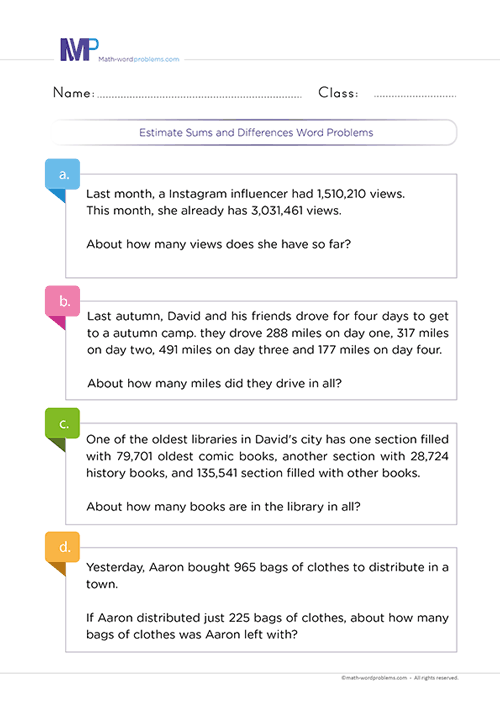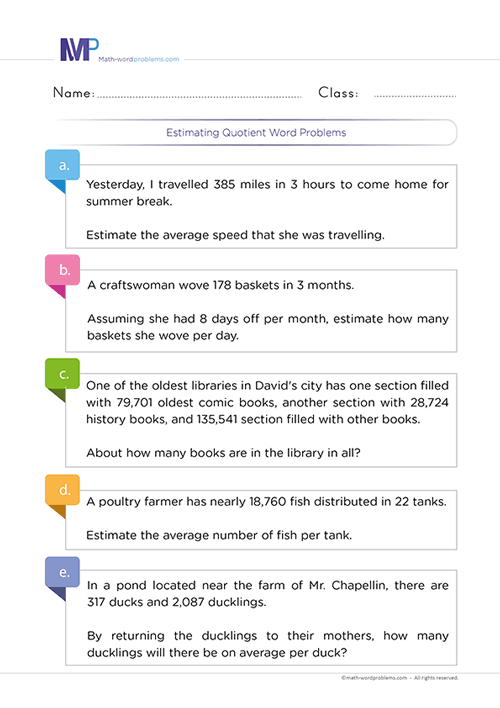 How to estimate sums and differences word problems
How to estimate sums and differences word problems
We often seek ways to teach our kids how to estimate sums and differences word problems. Hence, our straightforward step-by-step guide will offer you all the tips and strategies you need to arrive at logical estimates of sums and differences word problems.
It is most important to note our unique and captivating solving process. First, we will focus on the situation that the problem is describing. Next, we will strive to understand the relationship between the problem statement /type and the mathematical equation before solving the problem.
By so doing, 5th graders will use their logical skills to carefully read and understand the word problem rather than diving straight to provide an answer or estimate to the problem in question.
Steps to solve estimation of sums and differences word problems
At this point, we will look at the steps to solve estimation of sums and differences word problems.
As we said earlier, our step-by-step guide to solving estimation of sums and differences word problems will greatly improve kids’ mathematical thinking, helping them to face more challenging estimation word problems accurately.
This resource is about teaching and showing kids how effective the schema-based strategy in solving math word problems is. With this, your little ones can quickly identify the problem statement that will lead them to acquire concrete estimates of sums and differences.
That notwithstanding, we have added some real-world examples below to show kids the powerful work these steps can do.
Step 1: IDENTIFY
To identify the problem, start by finding out the scenario the problem wants you to solve. For instance, does the problem need you to perform addition, subtraction, or any other operation? You can do this by finding out the most important keywords in the word problem. These keywords are listed below.
- Firstly, suppose it is estimating whole numbers involving addition word problems. In that case, you will see at least one of the keywords below: - add, plus, more, total, increase, together, Altogether, combined, sum, grow, join, both, in all, and, how many in all, how much, spend in all, etc.
- Secondly, when it comes to estimating whole numbers involving subtraction word problems, you will see at least one of the keywords below in the word problem: - less, minus, take away, left, decrease, difference, fewer, deduct, remain, change, how many more, leftover, less than, how much longer/shorter, how much more, fewer than, discount, etc.
- Finally and most importantly, there are two ways to know if a word problem actually requires you to estimate. If you find the words “about …“and “estimate …” in a word problem, then it is an estimation problem.
In addition to this, you have to take note of the following:
- Know and understand your place values.
- Know when to round up or down.
Note: One key Element for learners to understand is that they should not always rely on keywords alone. That is to say; the same keyword can have different meanings in different word problems.
For this reason, we reiterate on the importance of reading the question very carefully to understand the situation that the word problem is describing, then figure out exactly which operation to use
Step 2: STRATEGIZE
How will you solve or tackle the word problem?
One key thing you should remember is that each word problem may require a different format. Hence, the key points below will enable young math learners to tackle any format however it comes.
- As mentioned above, from the keyword(s) in the word problem, you will know if you need to add, subtract, multiply or divide.
- However, know that you must not rely only on keywords. Instead, try to understand the situation that the problem is describing.
- After knowing which operation you will perform, construct short expressions/sentences to represent the given word problem.
Step 3: SET UP
Now, write down a numerical equation representing the information given in the word problem.
Step 4: PROVIDE A SOLUTION
From Step 3 above, estimate and add or subtract the numerical equation. Always recall the unit of measurement, if any.
There are a few steps to follow when estimating or rounding.
- Firstly, look at the number to the immediate right of the digit to be rounded.
- Then, if that number is 0-4, keep the digit (to be rounded) unchanged, then replace all numbers to its right with 0
- But if that number is 5-9, increase the digit (to be rounded) by 1, then replace all numbers to its right with 0.
Step 5: CHECK YOUR WORK
Ask yourself this question. “Does my answer make sense” If “YES,” you are done. If “NO,” go back to step 1 and start all over again.
Examples on how to solve estimation word problems
Example one: Here is an example on how to estimate subtraction word problems.
Step 1: Frist, the important numbers here are 989,745,456 and 175,256,000. The keyword(s) found in the word problem is “how many more.”
Step 2: Next, how will you solve the problem? The keyword(s) found in the word problem shows that we have to use a subtraction operation. Also, the phrase “about” shows that we need to estimate.
Now, form short sentences to represent the given word problem.
Now, form short sentences to represent the given word problem.
- Number of candies they sold during the Halloween month = 989,745,456.
- Number of candies they sold during the month immediately after Halloween month = 175,256,000.
- The number of more candies sold in the month of Hallowen than immediately after Halloween month = the number of candies sold during the month of Halloween – the number of candies sold in the month immediately after Halloween month
- Therefore, the estimated number of more candies they sold in the month of Halloween than the month immediately after Halloween = the estimated number of candies they sold during the Halloween month + the estimated number of candies they sold during the month immediately after Halloween month.
Step 3:Now, write down a numerical expression to represent the bolded sentence in step 2 above to solve this word problem:
→989,745,456 - 175,256,000 = ?
Step 4: From step 3 above, estimate and subtract the whole numbers by following the steps below.
Firstly, look at the number to the immediate right of the digit to be rounded.
- Firstly, look at the number to the immediate right of the digit to be rounded.
- Then, if that number is 0-4, keep the digit (to be rounded) unchanged, then replace all numbers to its right with 0
- But if that number is 5-9, increase the digit (to be rounded) by 1, then replace all numbers to its right with 0.
Therefore, they sold about 800,000,000 more candies in the month of Halloween than the month immediately after Halloween.
Step 5: Finally, check your work – Ask yourself this question. “Does my answer make sense?” If “YES,” you are done. If “NO,” go back to step 1 and start all over again.
Example two: How to estimate addition word problems.
Step 1: Frist, the important numbers here are 789, 9,945, and 2,956. The keyword(s) found in the word problem is “how many.”
Step 2:Next, how will you solve the problem? The keyword(s) found in the word problem calls for you to use an addition operation, and the phrase “about” shows that we have to estimate.
Now, construct short sentences to represent the given word problem.
- Number of jars they sold on Monday = 789.
- Number of jars they sold on Tuesday = 9,945.
- Number of jars they sold on Wednesday = 2,956.
- The number of honey jars they sold from Monday through to Wednesday = the number of honey jars sold on Monday + the number of jars sold on Tuesday + the number of jars sold on Wednesday.
- Therefore, the estimated number of jars of honey they sold from Monday through to Wednesday = the estimated number of jars they sold on Monday + the estimated number of jars sold on Tuesday + the estimated number of jars sold on Wednesday.
Step 3:Then, write down a numerical equation for each bolded sentence in step 2 above to solve this word problem:
789 + 9,945 + 2,956 = ?
Step 4: From Step 3 above, estimate and add the whole numbers by following the steps below.
- Firstly, look at the number to the immediate right of the digit to be rounded.
- Then, if that number is 0-4, keep the digit (to be rounded) unchanged, then replace all numbers to its right with 0
- But if that number is 5-9, increase the digit (to be rounded) by 1, then replace all numbers to its right with 0.
** Since one of the addends has only three digits, you have to round it to the nearest hundreds and round the other addends with four digits to the nearest hundreds.
We do this only in cases where the rounding place for each number is not specified**
So, they sold about 13,700 jars of honey from Monday through to Wednesday.
Step 5: Finally, check your work – Ask yourself this question. “Does my answer make sense?” If “YES,” you are done. If “NO,” go back to step 1 and start all over again.






